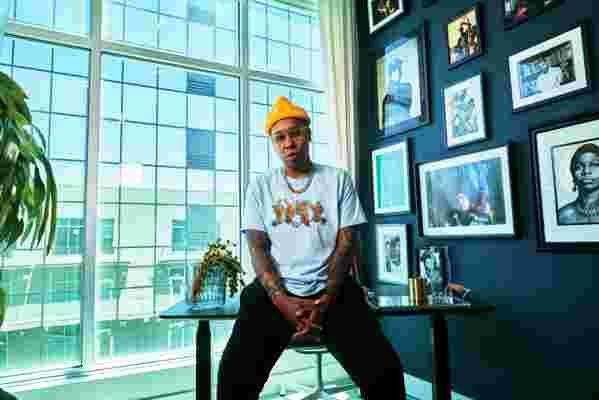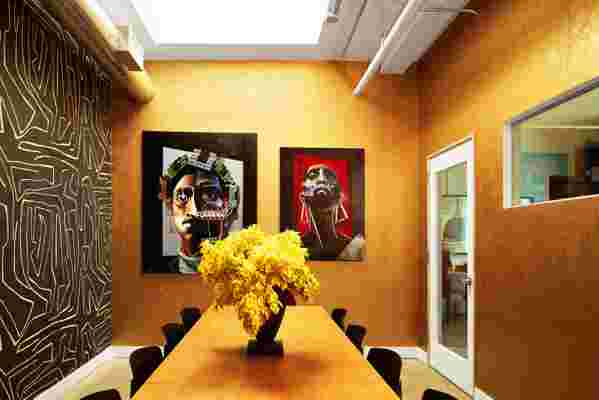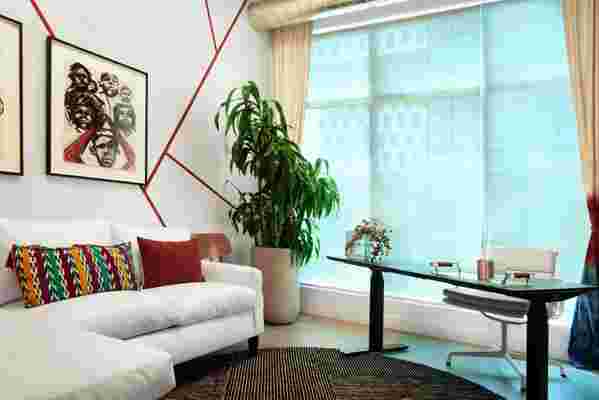Hollywood Powerhouses Lena Waithe and Rishi Rajani Take AD Inside Their Los Angeles Office
Lena Waithe, the prolific writer-producer-actor, named her production and development company, Hillman Grad, after the fictitious historically Black college that was the locus for A Different World, the pioneering television series that ran for six seasons on NBC from the late 1980s to the early ’90s. “That show said to the world that being Black and being intelligent was cool. It celebrated the Black nerd and the Black woman who wanted to major in art history. It was all about a community, a tribe, and that’s how I think of Hillman Grad,” says Waithe, the first African American woman to win an Emmy for writing in a comedy series, for her work on Master of None . (Her ample producer credits include The Chi and Boomerang, both currently on view, as well as Them: Covenant, a horror anthology series created by Little Marvin, and The 40-Year-Old Version, Radha Blank’s semi-autobiographical film about a New York playwright who abandons the theater world and all its micro- and macro-racial aggressions to become a rapper.)

Waithe in her private office.
Working in tandem with her producing partner Rishi Rajani, the company’s president of film and television, Waithe has, in the span of a few short years, established Hillman Grad as a Hollywood powerhouse and an engine of change, elevating the work of BIPOC talents from the writers room to the boardroom, in front of the camera and behind. “We want to give a voice to a broad range of people who have traditionally been marginalized—because of their race, sexual preference, financial means, geographical location, and other factors. I think we surprise people in terms of who we give the spotlight to and who we put the spotlight on,” Rajani explains.

The conference room is wrapped in a gold cork wall covering by Candice Olson and a Kelly Wearstler for Lee Jofa wallpaper.

Waithe’s private office; Wall covering by Aux Abris ; Carpet by Tom Dixon .
When the time came for Hillman Grad to move into a proper office, it was clear that the conventional Tinseltown-status model—sleek white walls for predominantly white people—was just not going to cut it. “We didn’t talk about aesthetics and particular styles,” Waithe says of early discussions between the Hillman Grad team and designer Amie Mays, who had collaborated with Waithe previously on the interiors of her Los Angeles home. “It was about a mood. The feeling had to be warm and colorful, with lots of texture. I wanted to be surrounded by Black art, murals, video loops of iconic moments of Black people in film and television—anything that speaks to my Blackness,” Waithe adds.
The inspiration wall in Waithe’s office features a painting of Nina Simone by Adrienne Muse .
Mays responded with a heady array of plush, polychromatic fabrics, an assortment of graphic and prismatic wall coverings—notably the conference room’s pairing of gold cork wallpaper and a pattern that nods to the striking lines of Kuba cloth—and classic midcentury furnishings that give a shoutout to the populist underpinnings of the modernist movement. There isn’t a sterile white wall in sight. “I tried to create a space that inspires people to make something beautiful, a space that feels comfortable and safe for the staff and all the visiting directors, actors, writers, and executives,” Mays says of her decorative ministrations.
A Different World mural by Adrienne Muse .
The reception area, anchored by a massive vintage Steve Chase sofa that Mays reupholstered in burgundy velvet, offers a deep immersion in the Hillman Grad vibe. Artist Adrienne Muse covered several walls in murals featuring portraits of performers such as Whitney Houston, a Waithe favorite, and the cast of A Different World . A mural by Swiss-Malian-American artist Penda Diakité further enlivens the reception zone’s vivid, staccato rhythm.
One wall of Waithe’s private office is covered in a salon-style hanging of images of trailblazing figures on the order of Nina Simone, James Baldwin, Shirley Chisholm, Oprah Winfrey, and Prince. “Black artists have always addressed the realities of living in a house that is burning,” Waithe says, bringing the conversation around to the question of making protest art in the era of Black Lives Matter. “Our job is to remind people how the fire started, why it continues to burn, and how we might contain it. You see that mission written in the Black and brown faces that cover our walls.”
An executive office is covered in a Farrow & Ball paint; Rug by CB2 .